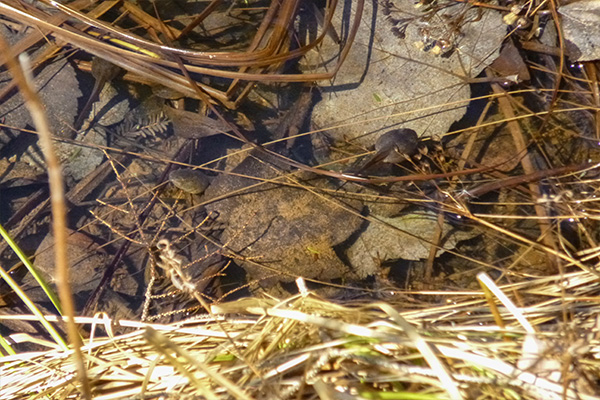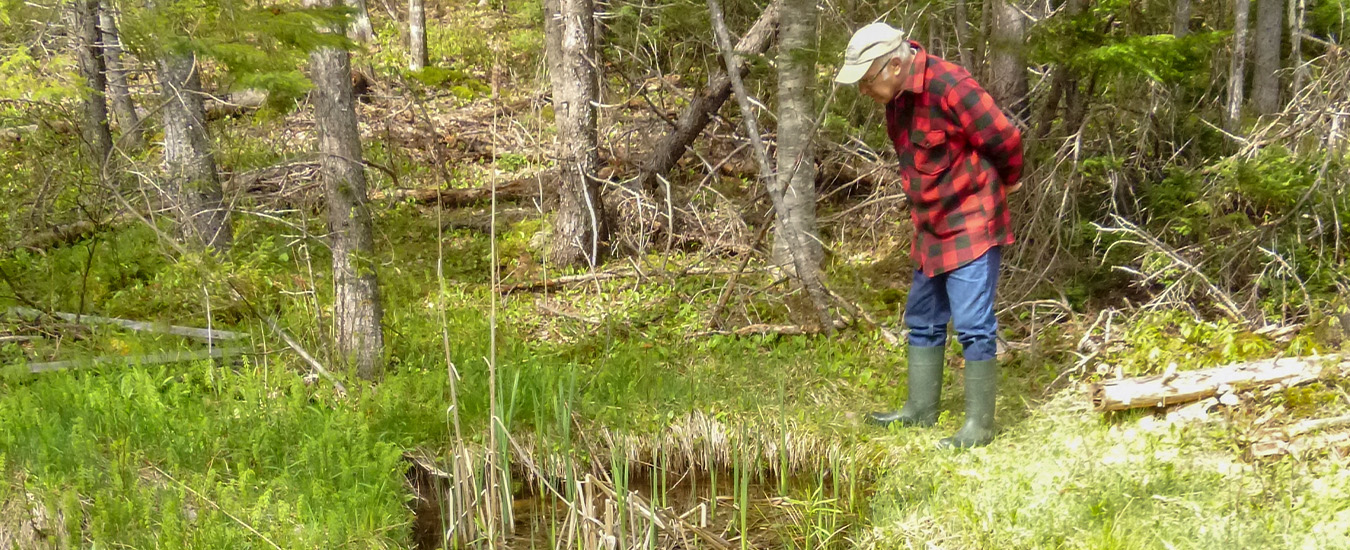Small woodland water caches provide haven for many creatures
Like most kids, puddles and pools fascinated me. Watching tadpoles, frogs and aquatic insects generated a sense of wonder that has persisted into adulthood. I remember finding dozens of miniature toads, freshly transitioned from tadpoles to adults, hopping off to a new life on land. They had no time for an identity crisis! As an adult with more educated eyes, my close scrutiny in some freshwater pools has occasionally revealed rare fairy shrimp.
A short distance from streams and rivers, healthy forests often contain shady, shallow depressions, frequently less than an acre in size, that become wet with spring meltwater. Poorly drained places, some of these pools hold water throughout the spring and summer, or at least into the dry season. Because they lack inlet and outlet streams, these so-called vernal pools usually contain no permanent, egg-eating fish populations. This offers a survival advantage for frogs, toads, and salamanders, so they migrate there annually to breed in the spring.
Cutting forests or clearing land for large or small developments may cause many small brooks, vernal pools and slightly deeper ponds to dry up and disappear due to increased exposure to sunlight, hot air, ground temperatures and the evaporative effects of wind.
Making new pools
I’ve spent 47 years adding habitats to my 56 acres of former farmland. Some fields were saved, but most pasturelands are new, early-succession forests. Years ago I found a small, wet spot where a four-toed salamander female was gallantly “guarding” eggs she’d laid in mosses that overhung a tiny pool. It was a drought year. It soon became apparent that her nursery was drying up before the tadpoles were sufficiently developed to leave. For several summers I hauled water with the tractor to maintain water levels in their pool to protect them from the raccoons, who would otherwise enjoy a fine dining experience.

A salamander basks in a vernal pool
The scarcity of woodland pools on my previously-farmed property prompted me to seek other damp spots in the newly treed, former pastures. I looked for locations I could access with the tractor during dry periods. Using the backhoe, I dug test holes in several wet places. I began monitoring their water levels, over the summer and fall.
Where water levels in my test holes remained sufficiently high for tadpole survival, I hired an excavator to dig a pool. In one case this was particularly fortuitous. Neighbours had infilled an old reservoir in the process of building a new house. The small reservoir had been a traditional, very loud gathering place for spring peepers. Luckily, the fall before, I had excavated a new vernal pool on a nearby site on our property. The next April, a spring peeper found it, began announcing its presence, and the peeper population shifted to the new pond. Without that new pond, the spring chorus would have been silenced.
Nature watching at a pool
Vernal pools are a delight to watch. The action begins about the time ice is melting, and continues throughout the spring, summer and fall. Sometimes I watch creatures moving under clear ice. Blue-spotted salamanders, yellow-spotted salamanders and red-spotted newts can be found breeding there. Toads, green frogs, northern leopard frogs and wood frogs also use the pools. A mixed frog chorus fills the air on calm spring evenings. All summer the green frogs “plunk” on, like banjo players, and the peepers squeak like some kind of bug, while hiding in vegetation and the moist forest floor.
Life has challenges for vernal pool inhabitants. Dragonflies lay their eggs in ponds and vernal pools. The eggs become larvae and can be deadly underwater predators. After high spring meltwater caused a brook to flood into one pool, I noticed a stickleback fish being eaten by a large dragonfly larva. I’m sure they also prey on young tadpoles.
Kingfishers will prey on tadpoles and dragonfly larvae. I’ve watched barred owls hunt adult frogs and tadpoles to feed their owlets. Mink stride down the brook carrying salamanders to feed their kits. Despite this predation, many amphibians survive to meet and mate the following year.
This south-facing wooded hillside also hosts a number of wet places in clay soils where the water table seeps to the surface, forming small pools no bigger than an umbrella. Often coming out of the ground under tree roots, their water trickles downhill, dampening the soil. One spring my wife Alice, while roaming the woods, investigated such a seep and found two freshly-dead garter snakes bearing many fine chew marks. The tiny bites indicated that a small animal had attacked them. Garter snakes have been located hibernating underwater elsewhere in their North American range. While emerging from the icy pool, these reptiles must have been found and killed by a hungry shrew while they were too cold and sluggish to escape.
Ponds and vernal pools usually have a healthy abundance of insect life. Squadrons of adult dragonflies and damselflies emerge from them in early summer to search for mosquitoes and other flying insects. To some extent, dragonflies are daytime substitutes for species like little brown bats, whose populations have been devastated by White-nose Syndrome.
On the pond’s surface you will find water striders and whirligig beetles wildly circling around like bumper cars. Below, water scorpions stealthily patrol the shallows, using tubes in their posteriors to breathe air from the surface, while giant water bugs hunt frogs and red-spotted newts that hide among aquatic plants. Predacious diving beetles can be seen hunting underwater. Look closely on the pool bottom and you may see caddisfly larvae living and moving around inside casings they construct of twigs, leaves, rocks, sand and gravel. In some ponds, leeches become meaty meals for visiting ducks.
Aquatic plant life arrives in many ponds as seeds on the wind or in the poop of so-called “puddle” ducks. Examples of the latter include black ducks, mallards, green-winged and blue-winged teal that can literally fly in, feed, then jump up and wing their way out of a very small pool.
Cattail plants can appear and gradually take over the pond surface. To maintain open water, I dig some out with a backhoe during late summer dry spells. Several salamander andfrog tadpoles overwinter in the muddy bottoms of pools and emerge as adults in their second year, so I dig slowlyand carefully.
Amphibian homes
The forest around a vernal pool has important habitat for amphibians. Their cool, moist skin renders them intolerant of dry weather and temperature extremes. Optimum forest habitat around a vernal pool should include damp ground with an organic, decayed leaf layer; some coarse, woody debris (large, dead wood); and shade provided by living, standing trees. The zone that adult frog and salamander species call home can extend a distance of 650-2000 feet (200–600 metres) away from the pool. Juvenile wood frogs may disperse as far as ¾ mile (1.2 km) away.
Eventually the four-toed salamanders found, and relocated to, a vernal pool I’d dug almost a half-kilometre from the original, vulnerable spot where I first found them. Now they’re raccoon-safe.
Building vernal pools has added a great deal of nature to this property, and much enjoyment for us!
